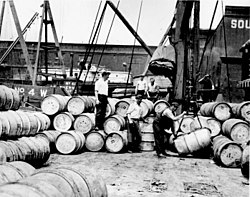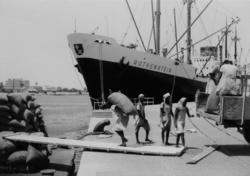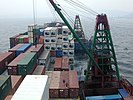Dockworker


A dockworker (also called a longshoreman, stevedore, or docker) is a
After the intermodal shipping container revolution of the 1960s, the required dockworkers declined by over 90%.[2]
Etymology
The word stevedore (
History
Dockworkers, also known as longshoremen and stevedores, have a long and storied history that dates back to ancient times. The role of dockworkers has evolved significantly over the centuries as maritime trade has grown and modernized. Here is an overview of the history of dockworkers.
- Ancient times: Dockworkers have been essential to maritime trade since ancient times. The Phoenicians, Greeks, and Romans all relied on dockworkers to load and unload cargo from ships at bustling port cities such as Carthage, Athens, and Ostia. These workers used manual labor and simple tools to handle goods, a practice that continued for centuries.[8][9][10][11]
- Medieval period: In the Middle Ages, dockworkers played a crucial role in the trade networks of Europe. The Hanseatic League, a powerful trading confederation in Northern Europe, employed dockworkers to handle goods at major ports like Lübeck and Bruges. The work was physically demanding and often dangerous, as dockworkers had to lift heavy cargo without modern equipment.[12]
- Industrial Revolution: The Industrial Revolution brought significant changes to the role of dockworkers. The introduction of steam-powered ships and railways revolutionized transportation, leading to increased trade volumes and the need for more efficient handling of cargo. Dockworkers organized into unions to protect their rights and improve working conditions, leading to the formation of organizations such as the International Longshoremen's Association in the United States.[13]
- Containerization: The 20th century saw a major shift in the work of dockworkers with the introduction of containerization. Containers revolutionized the shipping industry by standardizing how goods were transported, leading to faster turnaround times and increased efficiency. Dockworkers adapted to this new technology by specializing in container handling and operating heavy machinery such as cranes.[14][15]
- Modern era: Today, dockworkers play a vital role in global trade, working in ports worldwide to ensure the smooth flow of goods. They handle a wide range of cargo, from containers to bulk commodities, and are essential for the functioning of the maritime industry. Despite advancements in technology and automation, dockworkers remain an indispensable part of the supply chain.[16]
Loading and unloading ships
| Admiralty law |
|---|
| History |
| Features |
| Contract of carriage/Charterparty |
| Parties |
| Judiciaries |
| International conventions |
| International organizations |
Loading and unloading ships requires knowledge of the operation of loading equipment, the proper techniques for lifting and stowing
In earlier days before the introduction of
Today, the vast majority of non-bulk cargo is transported in intermodal containers.[17] The containers arrive at a port by truck, rail, or another ship and are stacked in the port's storage area. When the vessel that will be transporting them arrives, the containers it is offloading are unloaded by a crane. The containers either leave the port by truck or rail or are stored until they are placed on another ship. Once the ship is offloaded, the containers it leaves with are brought to the dock by truck. A crane lifts the containers from the trucks onto the ship. As the containers pile up on the ship, the workers connect them to the vessel and the other already-placed containers. The jobs involved include the crane operators, the workers who connect the containers to the ship and each other, the truck drivers who transport the containers from the dock and storage area, the workers who track the containers in the storage area as they are loaded and unloaded, as well as various supervisors. Those workers at the port who handle and move the containers are likely to be considered stevedores or dockworkers.
Before containerization, freight was often handled with a
Traditionally, stevedores had no fixed job but would arrive at the docks in the morning seeking employment for the day.
Dock workers have been a prominent part of the modern
- Container handling in Hong Kong – 2005
-
At anchor, twobargeswith cranes (floating derricks) at port
-
A container is lifted from the deck.
-
Dockworkers on the containers in the ship's hatch
-
Strong tidal current, loading work in adverse conditions
By country
The examples and perspective in this article deal primarily with the English-speaking world and do not represent a worldwide view of the subject. (September 2016) |
Australia
In
The
In 1943, dockworkers in Melbourne and Sydney were deliberately exposed to mustard gas while unloading the ship Idomeneus. Many suffered death and permanent disability—all as a result of military secrecy.[23]
Japan
Several dockworkers' unions exist in Japan.
New Zealand
New Zealand usage is very similar to the Australian version; "waterside workers" are also known as "wharfies." The 1951 New Zealand waterfront dispute, involving New Zealand dockworkers, was the most significant and most bitter industrial dispute in the country's history.[This paragraph needs citation(s)]
United Kingdom
In the United Kingdom, the definition of a stevedore varies from port to port. In some ports, only the highly skilled master of a loading gang is referred to as a "stevedore". "Docker" is the usual general term used in the UK for a worker who loads or unloads ships and performs various other jobs required at a seaport.
In some ports, a stevedore is a person who decides where cargo is stowed on a ship for safe stowage and even balance of a ship. It is not a hands-on role.[citation needed]
It was once known to refer to those working on a ship—loading or unloading the cargo—as stevedores, while those working on the quayside were called dockers.
In the ports along the Thames, stevedores load, while dockers unload (according to Michael Budge, ex docker, Tilbury and Dave Penn, ex docker, Tilbury, 1978–2018).[full citation needed]
United States

In present-day American waterfront usage, a longshoreman is usually a person or a company who manages the loading or unloading of a ship. In the early 19th century, the word was traditionally applied to black laborers or enslaved people who loaded and unloaded bales of cotton and other freight on and off riverboats. In Two Years Before the Mast (1840), the author Richard Henry Dana Jr. describes the steeving of a merchant sailing ship in 1834. This was the process of taking a mostly full hold and cramming in more material. In this case, the hold was filled with hides from the California hide trade up to four feet below the deckhead (equivalent of 'ceiling'). "Books" composed of 25–50 cattle skins folded into a bundle were prepared, and a small opening was created in the middle of one of the existing stacks. Then, the book was shoved in using a pair of thick, strong pieces of wood called steeves. The dockworkers had one end shaped like a wedge, placed into the middle of a book to shove into the stack. The other ends were pushed on through block and tackle and attached to the hull and overhead beams, which sailors hauled on.
Typically one ethnic group dominated the longshoreman market in a port, usually the Irish Catholics, as seen in the 1954 film about New York On the Waterfront.[27] In New Orleans there was a competition between the Irish and the blacks.[28]
In the
It is common to use the terms "stevedore" and "longshoreman" interchangeably.[30] The U.S. Congress has done so in the Ship Mortgage Act, 46 app. U.S.C. section 31301(5)(C), which designates both "crew wages" and "stevedore wages" as preferred maritime liens. The statute intended to give the wages of the seamen and dockworkers the same level of protection. Sometimes the word "stevedore" is used to mean "the man who loads and unloads a ship" as the British "docker".
Today,[when?] a stevedore typically owns the equipment used in the loading or discharge operation and hires dockworkers who load and unload cargo under the direction of a stevedore superintendent. This type of work along the East Coast waterfront was characteristic of ports like New York, Boston, and Philadelphia.
Today, a commercial stevedoring company also may contract with a
One union within the

Notable dockworkers
This section needs additional citations for verification. (April 2021) |
Former stevedores and dockworkers include:
- Crispus Attucks – American patriot
- International Longshore and Warehouse Union (ILWU)
- Joey Coyle – basis for the movie Money for Nothing
- Jack Dash – British dock workers' trade union leader
- Danny Greene – American mobster
- London Dock Strike of 1889
- Peter MacKay – Canadian former government minister and conservative party leader (a stevedore for two summers while a teenager)[32]
- Bruce Nelson – labor historian, author of Workers on the Waterfront
- painter from Buenos Aires, Argentina. His works reflect the work at the docks in La Boca, a portuary district of Buenos Aires.
- Stan Weir – blue-collar intellectual and sociologist, founder of Singlejack Press
In popular culture
- In 1949, reporter New York Sun.
- The material from Malcolm Johnson's investigative series was fictionalized and used as a basis for the influential film On the Waterfront (1954), starring Marlon Brando as a longshoreman, and the working conditions on the docks figure significantly in the film's plot. On the Waterfront was a critical and commercial success that received twelve Academy Award nominations and won eight, including Best Picture, Best Actor for Brando, Best Supporting Actress for Eva Marie Saint, and Best Director for Elia Kazan. The American Film Institute ranked it the 8th-greatest American movie of all time in 1997 and 19th in 2007.[33]
- Playwright Arthur Miller was involved in the early stages of the development of On the Waterfront; his play A View from the Bridge (1955) also deals with the troubled life of a longshoreman.[34]
- In The Wire, which first aired in 2003, the Stevedore Union and its members working in Baltimore, particularly Frank Sobotka, figure prominently in the second season's story.[35][36]
- The American film Ray Stevenson as Danny Greene, head of the Longshoreman's Union.[37]
See also
- 1913 Sligo Dock strike
- Admiralty law
- Battle of Ballantyne Pier (Canada)
- Dockers Union (disambiguation)
- Dunnage
- Federated Ship Painters and Dockers Union
- History of Squamish and Tsleil-Waututh longshoremen, 1863–1963
- International Longshore and Warehouse Union (United States)
- Liverpool dockers' strike (1995–98)(UK)
- Mersey Docks and Harbour Company
- Mudlark
- National Union of Dock Labourers
- Scottish Union of Dock Labourers
- Teamster
- Weeks Marine
References
- ^ "Dockworker". Dictionary.com. Retrieved August 27, 2023.
- ^ Khan, Khalil U. (15 September 2014). "Stevedoring & The Role of Stevedores in Shipping". The International Institute of Marine Surveying (IIMS). Retrieved 7 April 2021.
- ^ David Maclachlan (1875). A Treatise on the Law of Merchant Shipping. W. Maxwell & Son. pp. 387–.
- ^ "Modern Greek Verbs – στοιβάζω, στοίβαξα, στοιβάχτηκα, στοιβαγμένος – I pile up". moderngreekverbs.com.
- ^ "Stevedores – definition of stevedores by The Free Dictionary". TheFreeDictionary.com.
- ^ "America on the Move collection". Archived from the original on June 12, 2007.
- ^ Paul Hellyer Papers, Library and Archives Canada, MG32 B33, Vol. 251.
- ^ Hazzard, Shirley (2008). The Ancient Shore: Dispatches from Naples.
- ^ Horejs, Barbara (2003). Ports of Trade: Al Mina and Geometric Greek Pottery in the Levant.
- ^ Casson, Lionel (1959). The Ancient Mariners: Seafarers and Sea Fighters of the Mediterranean in Ancient Times.
- ^ Casson, Lionel (1994). Seafaring in Ancient Times.
- ^ Meier, Dirk (October 15, 2009). Seafarers, Merchants, and Pirates in the Middle Ages.
- ^ "The position of dockers and sailors in 1897 and the International Federation of Ship, Dock and River Workers". www.marxists.org. Retrieved 2024-02-14.
- ^ "Labor on the Waterfront". South Street Seaport Museum. Retrieved 2024-02-14.
- ^ "The ILWU Story". ILWU. Retrieved 2024-02-14.
- ^ Container Terminals and Cargo Systems: Design, Operations Management, and Logistics Control Issues. By Kap Hwan Kim (Editor), Hans-Otto Günther (Editor). Springer. 2007.
{{cite book}}: CS1 maint: others (link) - ISBN 0-691-12324-1.
- S2CID 246479077.
- ^ Standing on the Stones BFI Film and TV Database, London Dockers (1964)
- ^ "shape-up". Dictionary.com. Random House Unabridged Dictionary. Retrieved 2008-05-15.
- ^ Blum, Howard (March 13, 1978). "The 'Shape-Up' on Piers Gives Way to 'Show- Up'". The New York Times. Retrieved 2019-10-13.
- ^ "British History in depth: Banners of the British Labour Movement". BBC.
- ISBN 978-1-922132-91-8.
- ^ Board, United States National Labor Relations (1993). Decisions and Orders of the National Labor Relations Board. National Labor Relations Board.
- ^ Kawaguchi, Miki (November 2014). "Negotiations and Agreements of Labor Unions and Employers in the Industrial Sector in Japan" (PDF). 日本労働研究雑誌 (Japan Labour Research Journal).
- PMID 17788469.
- ^ Fisher, James T. (2010). On the Irish Waterfront: The Crusader, the Movie, and the Soul of the Port of New York.
- ^ Arnesen, Eric (1994). Waterfront Workers of New Orleans: Race, Class, and Politics, 1863–1923.
- ^ Hollowak, Thomas L. (1996). A History of Polish Longshoremen and Their Role in the Establishment of a Union at the Port of Baltimore. Baltimore: History Press.
- ^ a b Delich, Helen. "Noted for Fast, Efficient Work Baltimore System of Operating is Termed Ideal for All Ports." Baltimore Sun, 1955.
- ^ Delich, Helen. "Ganging Up on the Water Front." Baltimore Sun, 1954.
- ^ MacKay, Peter (August 25, 2012). "Peter MacKay learned to appreciate Arctic life working as a stevedore". National Post. Retrieved March 13, 2023.
- ^ Rapf, Joanna E. (2003). On the Waterfront. Cambridge University Press.
- ^ Epstein, Arthur D. (1965). "A Look at A View from the Bridge". Texas Studies in Literature and Language. 7 (1): 109–122.
- S2CID 161316328.
- S2CID 155014315.
- ^ Porrello, Rick (2011). Kill the Irishman. Simon and Schuster.
Further reading
- Arnesen, Eric (1994). Waterfront Workers of New Orleans: Race, Class, and Politics, 1863–1923.
- Connolly, Michael C. (2010). Seated by the Sea: The Maritime History of Portland, Maine, and Its Irish Longshoremen. University Press of Florida.
- Callebert, Ralph (2017). On Durban's Docks: Zulu Workers, Rural Households, Global Labor. University of Rochester Press.
- Davis, Colin J. (2003). Waterfront Revolts: New York and London Dockworkers, 1946–61.
- Land, Isaac (2007). "Liberty on the Waterfront: American Maritime Culture in the Age of Revolution". S2CID 143564724.
- Mello, William J. (2010). New York Longshoremen: Class and Power on the Docks.
- Nelson, Bruce (1990). Workers on the Waterfront: Seamen, Longshoremen, and Unionism in the 1930s.
- Parnaby, Andrew (2008). Citizen Docker: Making a New Deal on the Vancouver Waterfront, 1919–1939.
- Phillips, Jim (2005). "Class and Industrial Relations in Britain: The 'Long' Mid-century and the Case of Port Transport, 1920–70" (PDF). Twentieth Century British History. 16 (1): 52–73. .
- Safford, Jeffrey J. (2008). "The Pacific Coast Maritime Strike of 1936: Another View". .
- Vaughan Wilson, Matt (2008). "The 1911 Waterfront Strikes in Glasgow: Trade Unions and Rank-and-File Militancy in the Labour Unrest of 1910–1914". .
- Velasco e Cruz, Maria Cecília (2006). "Puzzling Out Slave Origins in Rio de Janeiro Port Unionism: The 1906 Strike and the Sociedade de Resistência dos Trabalhadores em Trapiche e Café". .
- "Longshore Workers and Their Unions". Waterfront Workers History Project.




